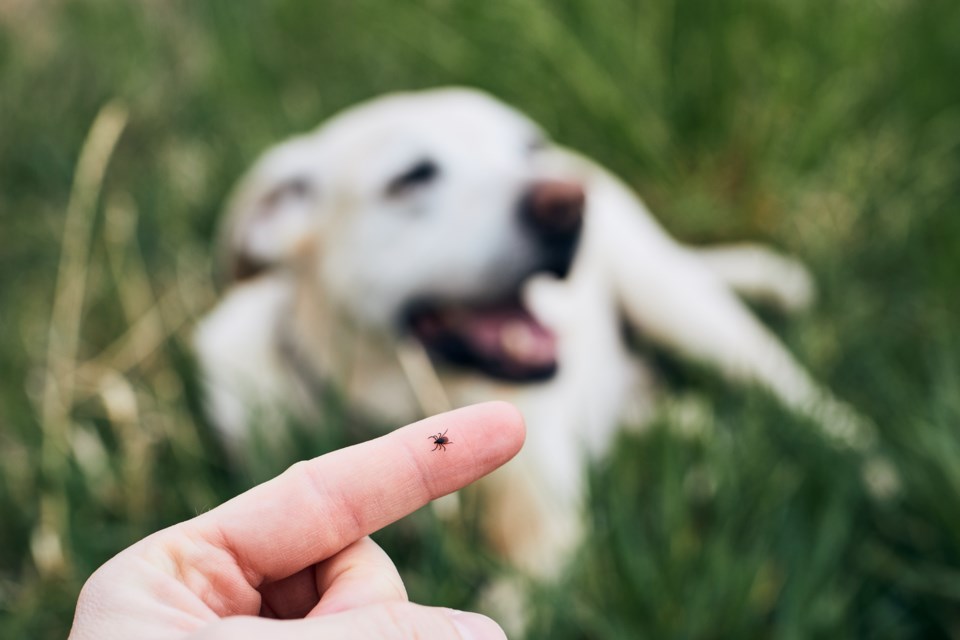During spring, ticks become more prevalent. They can’t fly or jump but they will latch on to your pants or shirt if you brush up against some tall grass that they were on. Ticks are mostly found in tall grass, brush, or wooded areas.
There are three ticks that are native to Saskatchewan. There are the Dermacentor variabilis (American dog tick), D. albipictus (Moose or Winter tick), and D. andersoni (Rocky Mountain wood tick). Fortunately, none of the native species of tick transmit Lyme disease. These three species have established (self-reproducing) populations in Saskatchewan.
There are two ticks that are not native to Saskatchewan, these two include Ixodes scapularis (eastern black-legged tick) and I. pacificus (western black-legged tick). Both ticks are known to carry Lyme disease. However, to date, there is no record of any established populations of black-legged ticks in Saskatchewan.
To prevent tick bites:
- Wear light-coloured clothes so ticks can be easily seen.
- Wear pants, long-sleeved shirts, and shoes that do not expose your bare feet.
- Pull socks over your pant legs to prevent ticks from crawling up your legs.
- Use insect repellents that contain DEET or Icaridin. Apply repellent to clothes as well as your skin. Always read and follow the directions on the label. Some repellents may have age restrictions.
- In Canada, clothing that has been treated with the insecticide permethrin has been approved for use by people over the age of 16.
- Shower or bathe as soon as possible after being outside to wash off loose ticks and inspect for attached ticks.
What to do when you find a tick on yourself or a pet:
- Carefully remove it with fine-tipped tweezers and grasp the tick's mouthparts as close to the skin as possible.
- Pull slowly upward and out with firm, steady pressure.
- Be careful not to squeeze, crush or puncture the body after removal.
Do not put Vaseline, gasoline, or other harmful substances on an attached tick.
Submit photos of the tick using the eTick system, and please keep ticks in a secure container until you receive the identification results. Ticks can be euthanized by placing them in a bag and storing it in the freezer 24 hours.
People should always be vigilant and check for ticks on themselves, their children, and their pets after being outside; taking precautions against ticks is the best way to reduce the risk of a tick bite.
In 2021, 969 ticks were identified and only 15 of these ticks were black-legged ticks. Nine of them were submitted for testing and none of them tested positive for Lyme Disease. Since 2008, 34,939 ticks have been identified. Out of those ticks, 94 were black-legged ticks and 13 tested positive for Lyme disease.
Lyme disease is an infection caused by the bite of a black-legged tick infected with the bacterium Borrelia burgdorferi. This is a serious illness that may affect your joints. If treated early with the correct antibiotics, most people will completely recover. Thankfully, the risk of Lyme disease is low in Saskatchewan.
Some symptoms of Lyme disease are:
- An expanding skin rash that looks like a ‘bull’s eye’ may develop at the site of the tick bite in 70 to 80 percent of infected persons. Some people may not develop a rash.
- Fever, chills, headache, muscle and joint pain, fatigue, or swollen lymph nodes.
- Later symptoms may include more rashes, dizziness, abnormal heartbeat, arthritis, mental confusion, inability to think clearly (brain fog), and nervous system disorders (involving the brain, nerves, and spinal cord).




